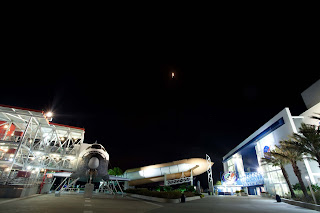STS 131 shuttle Discovery, carrying 7 astronauts was bound for the International Space Station. We arrived at the area that we decided to view the launch along with several other thousands of people who came out to view the launch. We scoped out the area and decided on viewing the launch from the Parrish Park area located along the A. Max Brewer Memorial Parkway on the way to Merritt Island.
We arrived at approximatley 4:30 am thinking we might be able to get a good spot for viewing the launch but to my dissmay there were already hundreds of people who had staked out their little bit of earth to enjoy the sky show.
A second bit of entertainmet for the upcoming launch was a flyover of the International Space Station about 6:06 am.
Everbody watched as the ISS flew just below the gibbous moon (half moon) and some tried to grab a picture as we all waited for the big sky show.
This was my second launch viewing which is just spectacular in the morning light. It was still dark and provided a spectacular show when the main engines ignited and lit up the early morning sky. I was poised with my two cameras both mounted on their respective tripods, one with the wide angle lense 17-49mm for a time exposure and my 500mm with a 1.4 converter giving me about 700mm reach. I had decided to use the video mode on my Canon 5D MK II with the 500mm and see just how it would work out. I was amazed how well everything came together. I realize to some the launch of rockets may be a little redundant or even boring but for a person who has never see such an event it is really awesome.
At 6:21 the shuttle lit up the early morning sky and everybody broke out in cheers. Below are some selected pictures that I managed to capture during the spectacular sky show.
I will try and post the video here and on youtube to share the experience.
Click on Image for larger view
The below image was approximatley 40 seconds after liftoff
click on image for larger view
This image was taken approximatley 55 seconds after liftoff and you can see the shuttle as a streak of light in the lower left hand corner of the picture
click on image for larger view
This photo is approximatley 10 minutes after the shuttle lifted off and the rocket exshaust plumes still lingered in the morning sky producing a colorful backdrop to the rising sun.
click on image for larger view












